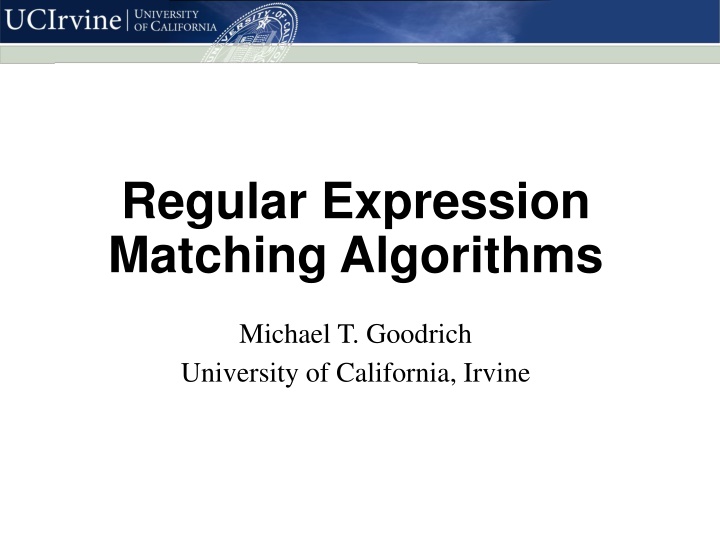
Regular Expression Matching Algorithms
Delve into the world of regular expressions with insights on REs, their language definitions, examples, converting REs to NFAs, and the induction process. Learn about the historical significance and applications in computer science.
Download Presentation

Please find below an Image/Link to download the presentation.
The content on the website is provided AS IS for your information and personal use only. It may not be sold, licensed, or shared on other websites without obtaining consent from the author. If you encounter any issues during the download, it is possible that the publisher has removed the file from their server.
You are allowed to download the files provided on this website for personal or commercial use, subject to the condition that they are used lawfully. All files are the property of their respective owners.
The content on the website is provided AS IS for your information and personal use only. It may not be sold, licensed, or shared on other websites without obtaining consent from the author.
E N D
Presentation Transcript
Regular Expression Matching Algorithms Michael T. Goodrich University of California, Irvine
REs: Review Regular expressionsare an algebraic way to describe languages. They describe exactly the regular languages. If E is a regular expression, then L(E) is the language it defines. An individual character is an RE, and we define RE s inductively using concatenation, or (union), and * closure. Parentheses may be used wherever needed to influence the grouping of operators. Order of precedence is * (highest), then concatenation, then | (lowest). 2
Examples: REs L((0|1)*101(0|1)*) = all strings of 0 s and 1 s having 101 as a substring. L((0|1)*1(0|1)*0(0|1)*1(0|1)*) = all strings of 0 s and 1 s having 101 as a subsequence. L(1*(1*01*01*01*)*1*) =all strings of 0 s and 1 s having a number of 0 s that is a multiple of 3. 3
Converting a RE to an -NFA Proof was published in 1968 by Ken Thompson. * 1983: Ken Thompson received the Turing Award (along with Dennis Ritchie). *He also invented Unix (w/ Dennis Ritchie) and the B language (which was a precursor to C, which was invented by Ritchie) Image from https://en.wikipedia.org/wiki/Ken_Thompson
Converting a RE to an -NFA Proof is an induction on the number of operators (or, concatenation, * closure) in the RE. We always construct an automaton of a special form: No arcs from outside, no arcs leaving Start state: Only state with external predecessors Final state: Only state with external successors 5
RE to -NFA: Basis Symbol a: a : : 6
RE to -NFA: Induction 1 Or For E1 For E2 For E1 | E2 7
RE to -NFA: Induction 2 Concatenation For E1 For E2 For E1E2 8
RE to -NFA: Induction 3 Closure For E For E* 9
Example For the RE ( |(a*b)): Image from https://en.wikipedia.org/wiki/Thompson%27s_construction
Analysis Note that each combination in the above construction adds only a constant number of nodes and edges in each step. So, if we start with an RE with m symbols, we will construct an equivalent -NFA of size O(m). Thus, we can determine whether a regular expression of size m matches a string of size n by converting the RE to an equivalent -NFA, converting that to an equivalent DFA, and using DFA simulation to test for a match in O(2m + n) time. Alternatively, we can use -NFA simulation to test for a regular-expression match in O(mn) time.
